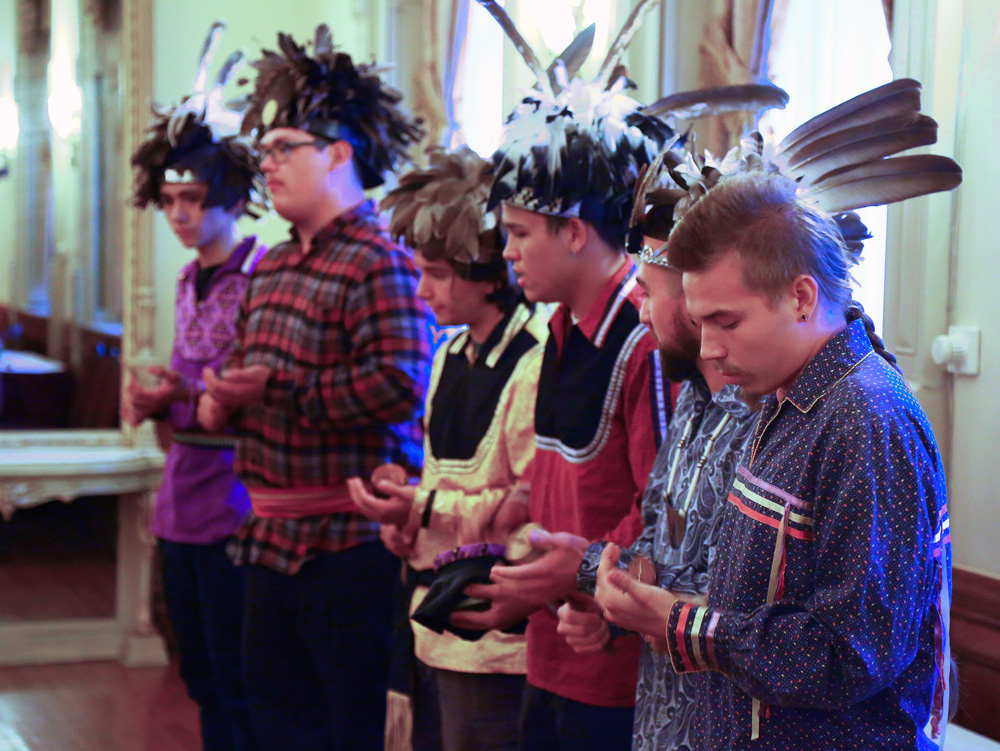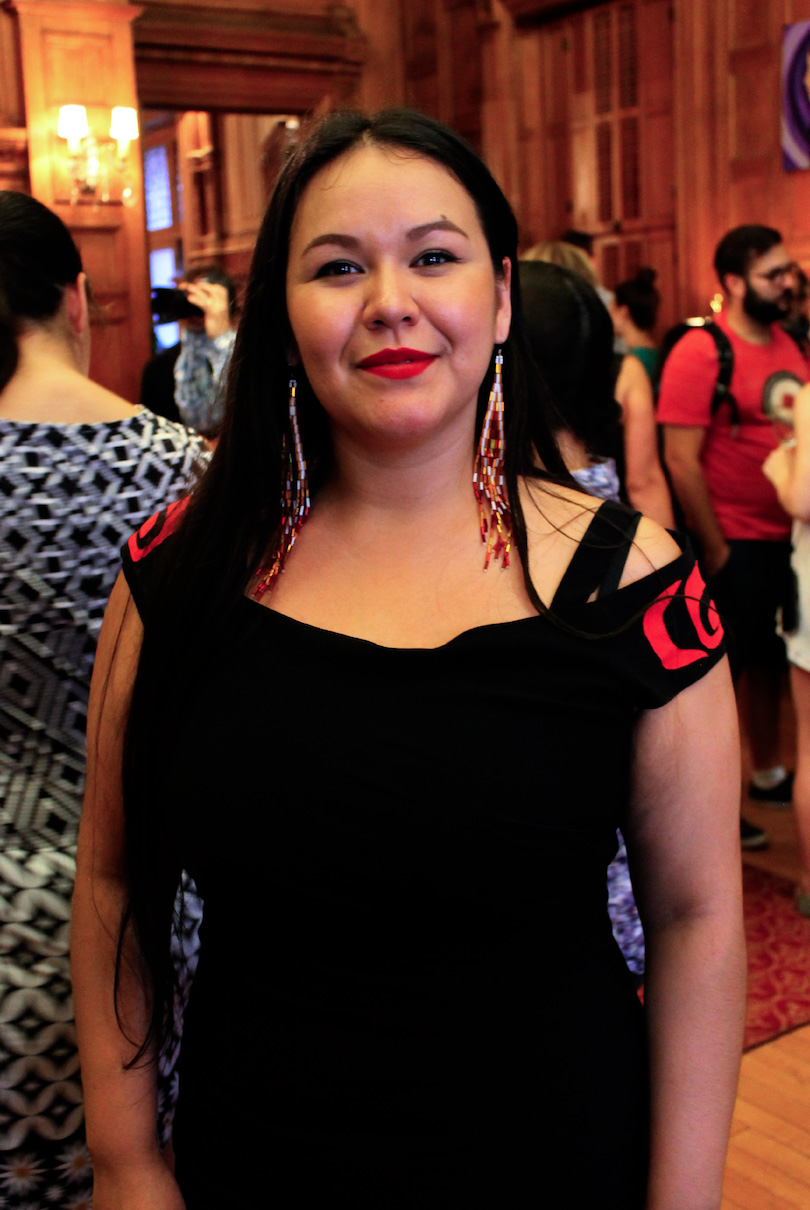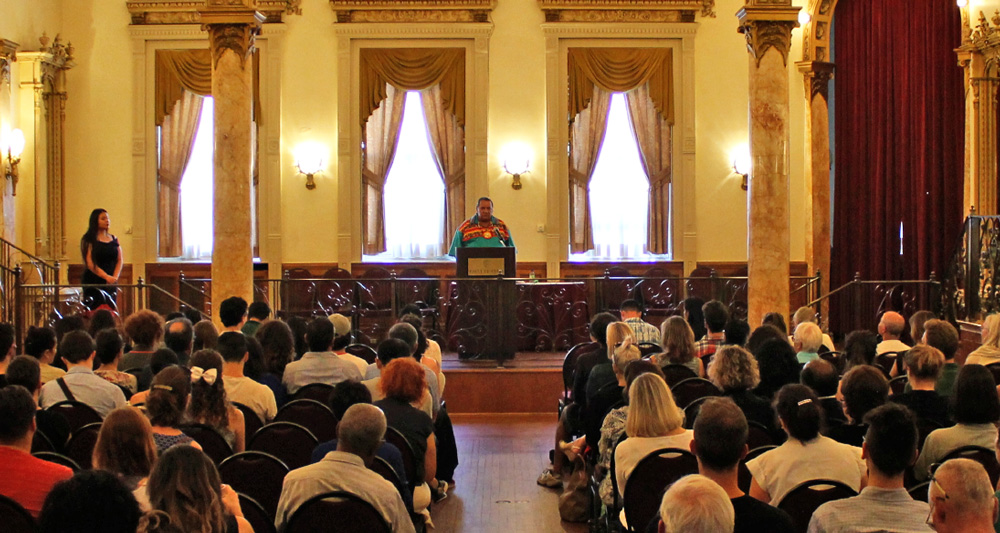
Some 200 people attended the launch of Indigenous Awareness Weeks (IAW) on Monday, September 17, at McGill’s Faculty Club. It was an upbeat evening of celebration, heart felt testimony, performance, art and indigenous food. Indigenous Awareness Week runs two weeks this year and will end on September 28.
The Faculty Club looked different for this year’s launch of IAW. Instead of the somewhat austere portraits of former McGill luminaries, there was a gallery of lively contemporary art by Mohawk artists. One of the pieces was the image on the IAW poster featuring a woman with flowing hair, representing Turtle Island, by Mohawk artist Tekaronhiahkhwa Margaret Standup (Turtle Island is the First Nations name for North America).

“We wanted to showcase Mohawk artists and art from Kahnawà:ke,” says Janelle Kasperski, a member of the Nisga’a Nation of Laxgalts’ap, BC.; the organizer of IAW; and Indigenous Education Advisor in the Social Equity and Diversity Education office. “Along with the Faculty Club and the Visual Arts Collection, we gave the paintings of the Faculty Club a rest, and guests were surrounded by Indigenous artwork created by local Kahnawà:ke artists.”
Mohawk Elder Charlie Patton welcomed people with Words Which Come Before All Things.
“We acknowledge and give thanks to our mother earth on which we stand. If you stand outside in a field you will see her beautiful green dress, the medicine that grows there, the food, and under that, the roots of all things, including where our ancestors sprang up.”
Kasperski read the original poem Warrior Women: A Letter to My Daughter, a meditation on Missing and Murdered Indigenous Women. “I grew up along Highway 16 – The Highway of Tears in BC,” she says. “When I was about 5 or 6 years old my mother took me to the very first candlelit vigil for families and community along Highway 16. When it came time to make posters, they decided to call it Highway of Tears for the first time. My poem is about what my mother wanted me to learn that day.”
Kakwiranó:ron Cook, a member of both the Mohawk Nation at Akwesasne (Quebec/Ontario/New York), and the Oglala Lakota Sioux Nation at Pine Ridge (South Dakota), also spoke at the Launch. Cook is Special Advisor, Indigenous Initiatives, in the Office of the Provost and Vice-Principal (Academic), Christopher Manfredi.
Cook is responsible for the implementation of the recommendations in the Final Report of the Task Force on Indigenous Studies and Indigenous Education, an initiative of Provost Manfredi.
“We are very proud of the work we are doing here at McGill,” says Cook. “We have made a lot of progress. But there are still only a few dozen First Nations administrators at McGill, out of roughly two thousand. We have a lot more work to do.”
There will be an IAW Macdonald Campus event later in the fall, around the time of the harvest ceremony in the Mohawk tradition, honouring the Three Sisters: Corn, Beans and Squash.
McGill’s First Peoples’ House annual Pow Wow is Sept. 21 – always a highlight in the McGill calendar, midway through the IAW schedule. On that day, the Six Nations Hiawatha Wampum Belt flag will fly from the Arts Building.
The Royal Canadian Mint will officially unveil a silver collector coin showcasing the Fancy Dance, a highlight of Pow Wow traditions, on the day of the McGill Pow Wow at McGill.
The line-up for this year’s Indigenous Awareness Weeks includes: a panel of leading Inuit women visual artists; a workshop/concert by blues performers Murray Porter & Elaine Bomberry; and a panel entitled “Commodification of Spiritual Items” with members of the Indigenous and Tibetan communities. Get the full schedule for Indigenous Awareness Weeks here.

